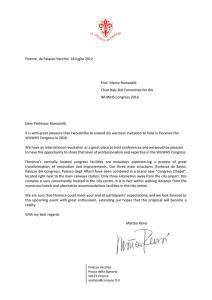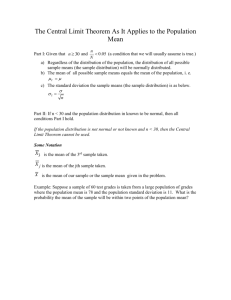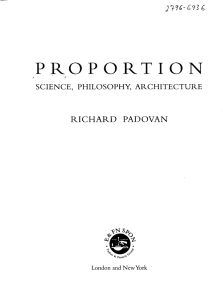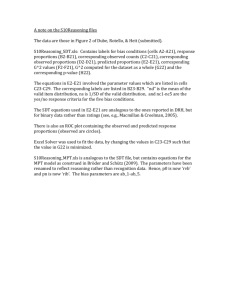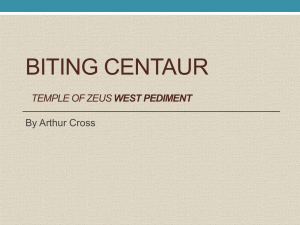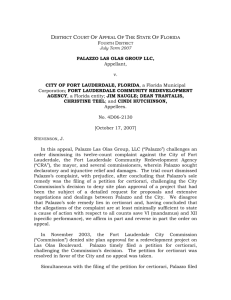Composition Drawings: Seeing, Drawing, Analyzing . . .
advertisement
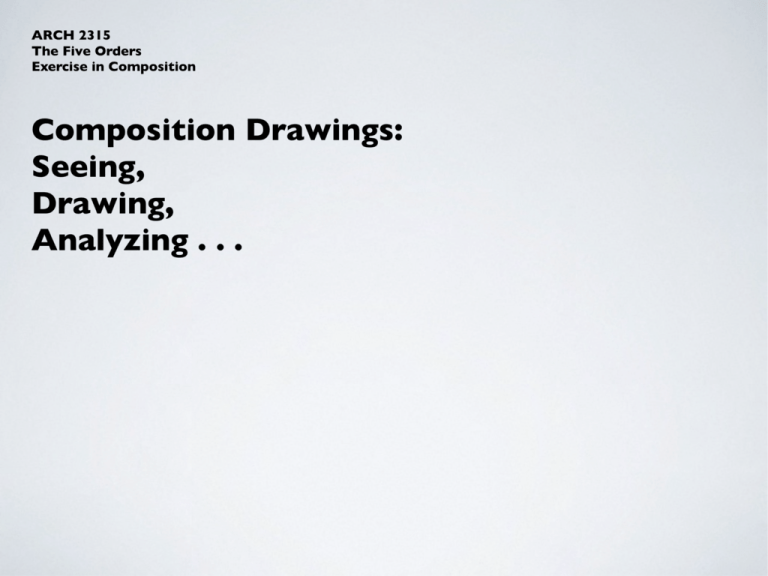
ARCH 2315 The Five Orders Exercise in Composition Composition Drawings: Seeing, Drawing, Analyzing . . . Palazzo Caprini (House of Raphael), Rome, Bramante, 1505 Composition Exercise Palazzo Caprini (House of Raphael), 1512, Rome, Bramante Proportions: Bramante regulated the elevation using a system of vertical and horizontal bays, and by openings (windows & doors) Contstants & Variables: In any design tradition, design follows some basic rules, one being the rule of Constants and Variables. Here we see Bramantes use of constants: A = width of bays, which regulate the elevation B = width of end bays, which ‘hold’ the composition C = height of arched openings, not including keystone, and of windows of the piano nobile, including the pediment D = height between floors, as regulated by the rustication and by the orders Constants are complemented by Variables: Bramante’s elevations can be diagramed as a variety of squares and rectangles, in various combinations that are in harmony with the whole of the composition. In this case, the Constants provide a framework in which variable relationships can be discerned. Study the geometries that regulate Bramante’s composition of the elevation, using diagonals as analytical tools. Compare both diagonal studies to the bay system below. * Note that in the top study, the diagonals show the basic dimensions of a square that regulate the composition. * Note that in the bottom study, the diagonals show the basic dimensions of a rectangle that regulate the composition. You’ll find that the rectangles are very close in their proportions to the Golden Rectangle, also known as the Golden Ratio * Note that in both cases, the proportions of the squares and rectangles are consistent in their relation to one another, regardless of their dimensions. * A well-composed elevation is the result of consistent proportions applied during the design process. Golden Rectangle, also known as the Golden Ratio 1. Draw a square, extending the base line and the top line futher to the right 2. Find the middle point of one side of the square (A) 3. Place the compass point at point (A) and the lead at point (B) 4. Draw the circle until it interects with the base line at point (C) 5. Draw a line from point (C) to point (D) 6. Note the ration of 1.618 You’ll find that few architects adhered strictly to the 1.618 ratio. Most likely, you’ll find that they made the easier (and sensible) choice to round it to whole numbers. In the comparison to the left, Note the close similarity of proportions among three rectangles. Pieces + Elements + Motifs = Composition Constant Pieces: 1. & 2. Rustication note variation in scale 3. Spring of Arch which creates belt course 4. Belt course divides rusticated ground floor from the Piano Nobile 5. Arch 6. Parapet 7. Pedimented Windows Variable Pieces: A. Column B. Segmental Pediment C. Triangular Pediment D. Balustrade E. Pedestal F. Flat Arch G. Oculus Motifs: A. Paired Columns note how they define the bay and frame the void of the window. B. Aedicula Window a structural framing device that gives importance to its contents. A motif taken from ancient shrines. Note how the pediment can vary. C. Balastraded Windows D. Rusticated Ground Floor A: below C: below B: below D: below Elevation Study: Note the various arrangements that the classical elements of the orders, balustrades, pediments, flat arches, and oculi allow in the composition. Referring to the previous slides, conduct a proportion study of of this chateau, designed by Ange-Jaques Gabriel in 1770 for Madame Louveciennes. In addition, list the pieces, elements, and motifs that you observe. All images are found in: Robert Chitham. The Classical Orders of Architecture. 2nd Edition. Oxford: Architectural Press, 2005. The scales attached to each plate require some explanation. The left and right margins of this plate contain graphical scales graduated in whole column diameters. These scales commence at zero at the underside of the square plinth of the column base, rising through the column and entablature, and falling through the pedestal. This is because the pedestal is the element most likely to be omitted when using the order in a design. To the right of each order is a further figured scale indicating for each the overall height of pedestal, column, and entablature. Plate 9 is intended to serve as a handy comparative reference or index to the orders, and can be used when making an initial choice of the order to be employed in a design. Plate 9 Note the ‘rough sketch’ to the left of the final drawing of the Roman Doric order. This ‘sketch’ is made for the basic dimensions and proportions of the order. You need only to consider the height of the pedestal, the height of the column shaft and its base and capitol, and the height of the entablature, divided into three parts. You may ‘eyeball’ or ‘guestimate’ the projections of the cornice, and etc. !"#$%&'()% *+,-./0,%/1%#23420/5/21%% !"#$%&'(()*'&$!+',)-)./$.0$1#()2/% Assignment (to be drawn by hand): Your “commission” is to design a facade for a palazzo that has a rusticated ground floor with interior floor to ceiling height of 12 feet, and a piano nobile with floor to ceiling height of 16 feet. There must be an odd number of bays. There is no attic story, but there is a parapet, and if you choose, a pediment. The client has chosen two sites: one has a long street front and is oriented horizontally; the other has a short street front and is oriented vertically. You are to choose one of these sites. Remarkably, the width of the site can vary according to your design. Both sites are in a dense urban context, and your design might be flanked directly by other buildings. It’s possible, however, that you could manage a garden gate to one side, or even both sides of the design. Keeping in mind the ‘rules’ of composition according to the Golden Rectangle, and using Common Lecture #2 and the pdf of The Five Orders as guides, choose one of the orders, which will regulate your design. Do not erase construction lines. Keep in mind these two traditions: 1. Renaissance architects were inventive, and part of this inventiveness was a willingness to be flexible with ‘the rules’ -- for example, few if any of Renaissance designs would directly accord to the golden ratio of 1.618. Rather, rounding to whole numbers was the ‘rule of thumb.’ 2. “All buildings are made from other buildings.” Meaning, we refer to precedents for a reason -- for inspiration and instruction. Therefore, google “palazzo renaissance” as a key word to see how architects of the past have approached this design problem. See the images below from google sources for two results of such a google search. Print and attach any precedents that you use because they will be useful for any comments or discussion about your design as it relates to precedents, choices you made, etc. Palazzo Civena, Vicenza, Italy, 1540, Palladio Palazzo Valmarana, Vicenza, Italy, 1565, Palladio

